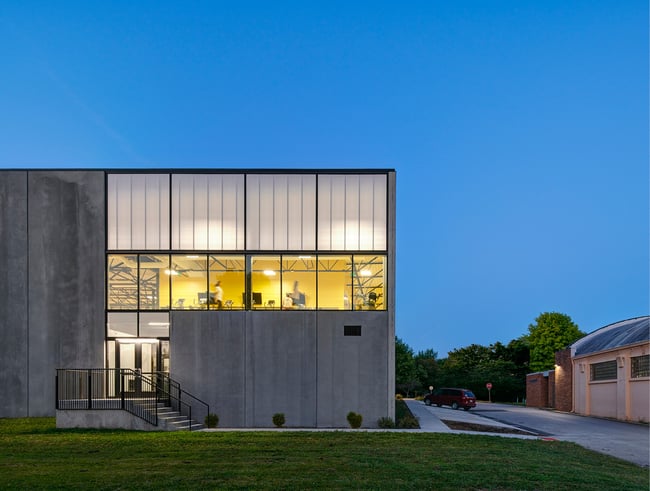Potential Problems with Choosing an Architect Based on Fee

A building project is a major expense for any organization, with long-term implications for your operations and the well-being of occupants. No building owner has an endless budget, making cost an obvious consideration when choosing an architect.
When selecting an architect, some owners may be tempted to base their decision on the fee. This is understandable. When faced with a tight budget, architectural services could seem like one place to save.
However, choosing an architect based on their fee—not qualifications—can have unintended consequences.
If you are taking on a building project, we want you to have the best experience possible. Our goal is to educate building owners about architectural services and the importance of this investment—whether you work with us or not.
This article will discuss the potential problems you can encounter when choosing an architect based on a fee. After reading, you will better understand the cost benefits of basing your decision on qualifications.
4 Potential Problems with Choosing an Architect Based on Fee
1. Shortcutting Pre-Design Planning
Successful building projects start with a clear vision. There are thousands of decisions during the architectural process, and your goals should influence each.
Early planning is crucial for establishing project goals. Pre-design activities like visioning workshops, programming exercises, and benchmarking tours help your team develop a set of priorities for vetting future design decisions.
Similarly, analyzing existing building and site conditions minimizes the chance of unexpected (and potentially costly) situations arising later in the process. By the end of pre-design, you should understand your project’s scope and the cost implications.
Pre-design forms the foundation of the work ahead, making it one of the most important stages of the process. While every project involves some degree of pre-design planning, a lower fee may suggest a lower level of engagement.

The fee reflects the level of engagement on a project.
Like any professional service, architects base their fees on the time and effort that goes into the project—as well as the experience of the design team. The fee should reflect the attention the project will receive in these crucial early phases.
When meeting with architects, ask about their process and their experience with engaging occupants on similar projects.
2. Potential for Increased Construction Costs
Every building owner wants to deliver their project within budget, and an architect plays a key role in accomplishing this goal.
In the early stages of the architectural process, your architect should test multiple high-level concepts and give a probable opinion of cost. As the design becomes more detailed, costs become more accurate. Research into systems and materials will help you better understand the full scope of your project’s construction cost.
Your architect should work to help you achieve the greatest value for your dollar, from systems to materials. When working on a tight budget, creating value requires additional research and planning.
The fee reflects the amount of time, research, and rigor going into the project. For example, research into materials and transportation costs helped deliver Lone Tree Wellness Center 11% below budget. In a time of inflated material prices and supply chain issues, additional planning can go a long way.

Additional research helped deliver Lone Tree Wellness Center below budget.
In short, a low fee may not cover the planning it takes to maximize the value of your budget. When meeting with architects, ask about their experience with maintaining budgets and their process for addressing issues like price escalation.
3. Value Engineering After Bidding
Value engineering is the process of analyzing systems, materials, and equipment to reduce costs while maintaining function.
When costs are not evaluated and maintained throughout the design process, value engineering may occur after bidding. Bids over the budget can lead to a situation where the building owner needs to reduce the quality, scope or both.
Changing a project’s scope becomes more difficult the closer you get to construction. Design components are an interconnected web, and when one element changes, others need to respond.
Often, value engineering after bidding forces an architect to remove a project component without the opportunity to change others accordingly. In the end, you may end up with a building dramatically different from the original vision. Managing costs throughout the design process will minimize the disappointment and stress of cost overages at the end of the project.
Ideally, your architect will mitigate this scenario by updating opinions of cost throughout the process. They should factor contingencies and escalation into the budget to account for unexpected price changes. If the bidding environment is volatile, they may even recommend bid alternates.
Most importantly, your architect should discuss costs honestly and often. When the going gets tough, they should guide you toward solutions that fulfill your project goals.
Setting clear goals in the early stages of the process and discussing operations and maintenance will help you parse your “wants” from your “needs.” Again, the fee reflects the level of research, planning, and service.
When meeting with architects, discuss quality assurance and their experience with public bidding. It is important to find someone who understands the process and has the experience to keep the project within budget.
4. Lower Quality Design
Perhaps the most obvious risk of choosing an architect based on fee is a lower-quality design.
A well-designed building is functional and improves the daily lives of its occupants. It should operate as intended and provide the efficiency needed to reduce the long-term costs of ownership.
Your architect should help you solve your current challenges and adapt to changes the future might bring. They should design for your unique needs—not provide a pre-determined solution.
Unique and innovative solutions take time and effort, which is reflected in the architect’s fee. Rather than the fee, it’s best to choose an architect based on qualifications. Your architect should have the experience and qualifications to help your organization overcome its challenges.
Learn More About Architectural Fees
While cost is a consideration when making any purchasing decision, there are far more factors to consider when choosing an architect. Architectural fees are only a fraction of a building’s construction cost, and construction costs are only a fraction of long-term operating expenses. Investing in an architect who shows a commitment to your goals can lead to long-term savings.
Architects are problem solvers. Their job is to understand your organization and offer solutions that provide a long-term return on investment. They also play a key role in maintaining your budget and keeping your project on track.
Choosing an architect based on qualifications—not fee—is the best way to achieve the value you deserve. Ask your architect about their experience and look for someone who understands the challenges your organization faces.
When evaluating proposals, determine what the architect includes in the cost of services. Architects have different ways of calculating fees, but evaluating each proposal will help you get an apples-to-apples comparison. Learn more by reading about fee proposals and how to evaluate fees.